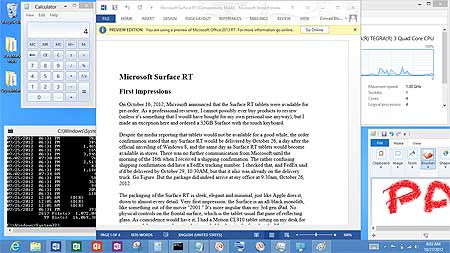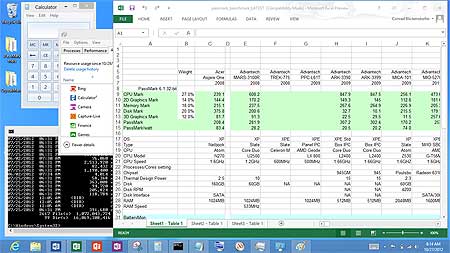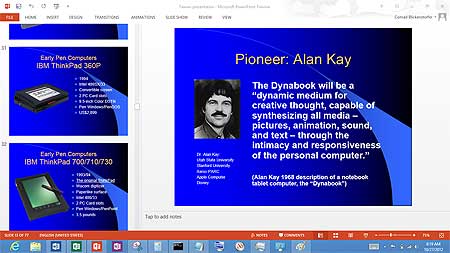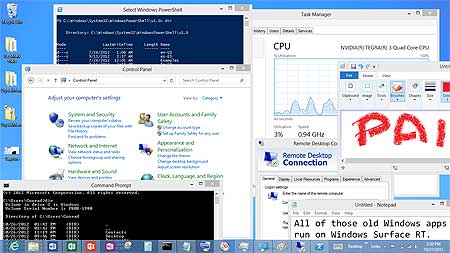« August 2012 | Main | November 2012 »
October 27, 2012
Windows RT: how suitable is it for vertical markets? (Part I)
Though as of this writing, October 27, 2012, Windows 8 and RT were just officially unveiled a couple of days ago, reams have already been written on Windows 8 and to a much lesser extent, Windows RT. We got our Surface RT tablet on October 26 with the intent on reporting on the Surface hardware and RT software in some detail. However, our emphasis will be on their suitability for vertical and industrial markets.
So what about Windows RT? The general word on it has been that it's a special version of Windows 8 for devices with ARM processors. A special version that will not be able to run any legacy Windows software, one that does not offer users the legacy desktop to go about their Windows business, and one where you cannot install software other than download it from the official Windows store. Engadget clearly stated in its review of Windows Surface: "Windows RT can't run legacy programs written for traditional, x86-based Windows systems."
Is this all so?
Yes, and perhaps no.
So here's what we found so far on our Surface tablet.
It comes with Microsoft Office 2013, and you run those versions of Word, Excel, PowerPoint and OneNote on the Windows RT desktop. We took screen shots of Word, Excel and PowerPoint, and here's what the apps look like (click on the pics for full-size versions):
Note that Office RT isn't final yet. It'll be a free download when it is. From what I can tell (and I am not an Office expert), even what comes with Windows RT now is a full version of Office, and not some micro version like Windows CE/Mobile used to have. This is the real thing.
Anyone who expected Office to be totally touch-optimized for Windows RT will be disappointed. It's not. You can use it with touch, but it can be a frustrating experience. And the touch keyboard doesn't help. Fortunately, you can simply plug in any old mouse or keyboard or mouse/keyboard combo and it works with Windows RT right off the bat.
Below is a screen capture of an Excel presentation. (and yes, I picked the slide that shows Alan Kay predicting it all back in 1968, and the original IBM Thinkpad tablet from 1993 on purpose).
If you take a closer look at our Word and Excel screen captures, you'll notice that not only are they in their own windows, we also have legacy Windows apps like Paint, Notepad, Calculator, the Math Input Panel, a system shell and the old performance monitor running. Interestingly, they do run (and many others, too, like Remote Desktop, Windows PowerShell, the whole Control Panel, etc.), and you can even pin them on the old Windows task bar. In fact, there's a lot of old legacy Windows stuff down in the basement of Windows RT. And much of it seems as functional as ever.
I am not sure what to make of that. After all, Windows is not supposed to run on ARM, yet a good number of the old programs do run. There's probably a good explanation for that.
Unfortunately, that doesn't mean you can simply install and run other old software. If you do, there's a message that says you can only install software from the Windows store.
So what's our preliminary impression of Windows RT on a Surface tablet? Quite positive. The 1.3GHz quad-core Nvidia Tegra 3 CPU has plenty enough power to make RT tablets perform well. The Nvidia setup doesn't need a fan and the tablet never even warms up, at all. And it seems to run almost ten hours on a charge.
Check back for more commentary on the suitability of Windows RT hardware and software for vertical markets.
Posted by conradb212 at 6:19 PM
October 16, 2012
Windows Surface tablets will be here shortly
Now this should be interesting. On October 16, 2012, Microsoft announced more detail on its upcoming Windows Surface tablets. And though labeled as a "pre-order" with limited amounts, customers could actually order the Windows Surface RT tablet of their choice from the Surface page on Microsoft's online store. For delivery on or before October 26th, i.e. within ten days.
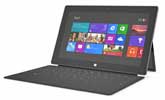 So the pricing of the Microsoft Windows RT tablets is no longer a secret. The basic 32GB tablet without a keyboard touch cover is US$499, the touch cover adds a hundred bucks, and the 64GB version with touch cover is US$699. That gets you a Microsoft-branded tablet that's as slender as the iPad, though it weighs a tiny bit more (1.5 vs 1.44 pounds). The Microsoft tablet looks wider because its 10.6-inch screen has a wide-format 16:9 aspect ratio compared to the iPad's 4:3.
So the pricing of the Microsoft Windows RT tablets is no longer a secret. The basic 32GB tablet without a keyboard touch cover is US$499, the touch cover adds a hundred bucks, and the 64GB version with touch cover is US$699. That gets you a Microsoft-branded tablet that's as slender as the iPad, though it weighs a tiny bit more (1.5 vs 1.44 pounds). The Microsoft tablet looks wider because its 10.6-inch screen has a wide-format 16:9 aspect ratio compared to the iPad's 4:3.
There's a standard USB port (which the iPad doesn't have) and a standard microSD card slot (which the iPad also doesn't have). There's a capacitive touch screen of course, and two 720p cameras, meaning the Surface tablet is for video and not so much for taking pictures (for that you'd want higher res). The 1366 x 768 pixel resolution is more than the original iPad and the iPad 2's 1024 x 768, and it's also what's called 720p in HDTV and video speak, so it should be good for video playback.
All the expected sensors are there: ambient light, accelerometer, gyroscope and compass, meaning the Surface will be able to do the same tricks customers have come to expect from modern apps. And speaking of apps, the Surface RT tablet comes with Microsoft Office Home and Student 2013 RT (see here). It's not the final, final version, but it'll be a free update when that becomes available.
There's WiFi and Bluetooth, but no mobile broadband, so these initial versions of Microsoft's RT Surface tablets will need to be within the reach of a WiFi access point to be online. The processor is of the Nvidia Tegra variety, i.e. the type that has been powering the majority of Android tablets out there.
What's new and different is Windows RT, a version of Windows that runs on ARM processors and doesn't need the presumably more complex x86-based hardware required to run full Windows. What exactly that means remains to be seen. It's said that the Surface RT tablets are aimed at the consumer market, but the iPad was, too, and now it's used almost everywhere. How exactly will Windows RT work? How will it resonate with customers who have come to expect elegant, effortless simplicity from tablets? No one knows just yet.
And how will it all relate to Surface tablets with full Windows 8, tablets that will, at least the Microsoft Surface versions, look very much like the Surface RT tablets, but have beefier hardware (anything from the latest Atom to third gen Core processors), higher resolution (1920 x 1080), and more storage? Will the two co-exist, with users selecting one or the other depending on their needs? The Windows 8 Pro versions will inevitably cost a good bit more, but how much more can a market bear where consumers have been spoiled with very inexpensive, very powerful notebook computers for years? Much will probably depend on how Windows 8 pans out.
Finally, what will it all mean to vertical and industrial market tablets? Will there be rugged tablets running Windows RT? Or will the ever-important leverage factor dictate that most enterprise and industrial tablets remain x86-based and compatible with legacy Windows? No one knows.
So for now I ordered a Surface RT tablet, just to see how it works and what it's all about.
Posted by conradb212 at 11:28 PM
October 2, 2012
Motorola Solutions' acquisition of Psion: Good, bad, or ugly?
Well, it's done. Psion is now part of Motorola Solutions. On October 12th, 2012, Ron Caines and Frederic Bismuth of Psion and Mark Moon of Motorola Solutions sent out the following note to their customers:
Dear Psion Customer:
We are writing to let you know that today Motorola Solutions completed the acquisition of Psion PLC.
Motorola Solutions is a leading provider of mission-critical communication systems and a pioneer in enterprise mobility solutions. The company has always been focused first and foremost on how to best serve its customers and chose to acquire Psion because of its complementary enterprise mobile computing products and its talented people who understand this highly specialized business. We are excited about what this opportunity brings you as a valued Psion customer. Bringing the Psion family of products onboard allows Motorola Solutions to extend its portfolio and better serve customers by delivering solutions in expanded use cases, especially in warehousing, cold chain, ports, yards and specialized modular applications.
Integration of the two companies has only just begun today. There will be no immediate changes to your account management, the partners that serve you or the products and services you receive from Psion. Customers who previously purchased or will purchase Psion products can be assured their products will be fully serviced and supported for the full duration of the contracts. All customer support numbers also remain the same.
Furthermore, Motorola Solutions is committed to investing jointly around its and Psion's technical strengths and capabilities to deliver compelling solutions for the various applications and markets that both Motorola Solutions and Psion have served.
Once we have worked through the details of the integration, we will share those plans with you. You can be assured that throughout this process we will remain focused on building on Psion's relationship with you and serving all of our customers.
If you have any questions, please contact us or your Psion representative. Thank you for your continued loyalty and support.
With many of the smaller, independent manufacturers of rugged computing equipment being swallowed up by larger companies, this was perhaps inevitable. To many rugged computing enthusiasts and insiders, also inevitable is the question "why?" as there is rather substantial product line overlap between the two companies. In an informal conversation, a Motorola source said that the acquisition of Psion was adding complementary handheld products and vehicle-mount terminals that complement Motorola's offerings. The acquisition, the source said, also supports their international growth strategy by providing an attractive, global-installed base.
That's certainly true, by if the history of such acquisitions has shown anything, it's the latter reason rather than the former. As is, purchased product lines almost inevitably get absorbed. They may live on for a while, but in the longer run it makes no sense to carry duplicate lines. That's too bad as Psion was really on to something with their modular approach to rugged handheld computing platforms. What will become of the innovative ikôn, Neo, and Omnii? The tough WorkAbouts? The panels that still have the old Teklogix' DNA?
So for now, we reflect on what was. Through Pen Computing and RuggedPCReview.com we covered Psion for a very long time. First those really terrific little clamshell handhelds that were better than anything based on Windows CE at the time, then the acquisition of Teklogix in 2000 (I was at the press conference in Chicago when it was announced), the Psion netbooks way before the world bought tens of millions of "netbooks," and always the rugged handhelds. We had a close relationship with Psion most of the time; at some point we even had a "Psion PSection" in Pen Computing Magazine (with some of the columns still online at pencomputing.com/Psion/psection.html).
So here's hoping that Moto Solutions will aim for, and succeed in, creating the synergy that is always given as the reason for an acquisition. After all, Moto's own for Symbol Technologies is well aware of the good (its own flourishing after being acquired by Moto), the bad (Intermec > Norand), and the ugly (Symbol > Telxon).
Posted by conradb212 at 3:11 PM
















